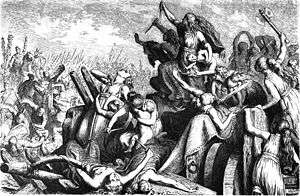Teutons


The Teutons (Latin: Teutones, Teutoni, Greek: "Τεύτονες") were an ancient tribe mentioned by Roman authors. They are generally classified as a Germanic tribe. The Teutons are best known for their participation in the Cimbrian War with the Roman Republic in the late 2nd century BC.
Origins
The Teutons are generally classified as a Germanic tribe.[1][2] Some historians have suggested a Celtic origin for the Teutones. It has been suggested that their name is Celtic though this is controversial.[2] Certain ancient writers classify the Teutones as Celts.[3] This might be explained by the fact that writers of the time did not clearly distinguish between Celtic and Germanic peoples.[3] A Celtic origin for the Teutones is nevertheless considered unlikely.
The early traveller of the 4th century BC, Pytheas, mentions the Teutones as inhabitants of the northern ocean coasts along with the Gutones. Strabo (64 or 63 BC – c. AD 24) and Marcus Velleius Paterculus (c. 19 BC – c. AD 31), moreover, classify them as Germanic peoples.[3] According to a map by Ptolemy, they originally lived in Jutland, which is in agreement with Pomponius Mela, who placed them in Scandinavia (Codanonia), implying that they may have originally inhabited both regions previously
The Cimbrian War
In the late second century BC, many of the Teutones (under their leader Teutobod) as well as the Cimbri and the Ambrones migrated from their original homes in southern Scandinavia and on the Jutland peninsula of Denmark, moving south and west to the Danube valley, where they encountered the expanding Roman Republic. The Teutones and Cimbri were recorded as passing west through Gaul before attacking Roman Italy.
After achieving decisive victories over the Romans at Noreia and Arausio in 105 BC, the Cimbri and Teutones divided their forces. Gaius Marius then defeated them separately in 102 BC and 101 BC respectively, ending the Cimbrian War. The defeat of the Teutones occurred at the Battle of Aquae Sextiae (near present-day Aix-en-Provence).
According to the writings of Valerius Maximus and Florus, the king of the Teutones, Teutobod, was taken in irons after the Teutones were defeated by the Romans. Under the conditions of the surrender, three hundred married women were to be handed over to the victorious Romans as concubines and slaves. When the matrons of the Teutones heard of this stipulation, they begged the consul that they might instead be allowed to minister in the temples of Ceres and Venus. When their request was denied, the Teutonic women slew their own children. The next morning, all the women were found dead in each other's arms, having strangled each other during the night. Their joint martyrdom passed into Roman legends of Teutonic fury.[4]
Some surviving captives reportedly participated as the rebelling gladiators in the Third Servile War of 73-71 BC.[5]
See also
References
- ↑ Waldman, Carl; Mason, Catherine (2006). Encyclopedia of European Peoples. Infobase Publishing. pp. 797–798. ISBN 1438129181.
The Cimbri are generally believed to have been a tribe of GERMANICS
- 1 2 Hussey, Joan Mervyn (1957). The Cambridge Medieval History. CUP Archive. pp. 191–193.
It was the Cimbri, along with their allies the Teutones and Ambrones, who for half a score of years kept the world in suspense. All three peoples were doubtless of Germanic stock. We may take it as established that the original home of the Cimbri was on the Jutish peninsula, that of the Teutones somewhere between the Ems and the Weser, and that of the Ambrones in the same neighborhood, also on the North Sea coast.
- 1 2 3 Chisholm 1911, p. 673.
- ↑ Lucius Annaeus Florus, Epitome 1.38.16–17 and Valerius Maximus, Factorum et Dictorum Memorabilium 6.1.ext.3
- ↑ Strauss, Barry (2009). The Spartacus War. Simon and Schuster. pp. 21–22. ISBN 1-4165-3205-6.
- Fick, August, Alf Torp and Hjalmar Falk: Vergleichendes Wörterbuch der Indogermanischen Sprachen. Part 3, Wortschatz der Germanischen Spracheinheit. 4. Aufl. (Göttingen: Vandenhoeck and Ruprecht), 1909.
![]()
External links
| Wikimedia Commons has media related to Teutons. |

